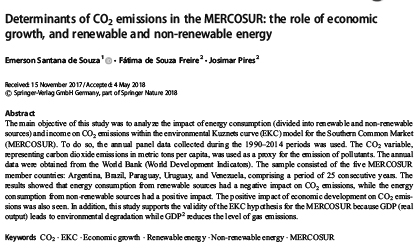The main objective of this study was to analyze the impact of energy consumption (divided into renewable and non-renewable sources) and income on CO2 emissions within the environmental Kuznets curve (EKC) model for the Southern Common Market (MERCOSUR). To do so. the annual panel data collected during the 1990–2014 periods was used. The CO2 variable. representing carbon dioxide emissions in metric tons per capita. was used as a proxy for the emission of pollutants. The annual data were obtained from the World Bank (World Development Indicators). The sample consisted of the five MERCOSUR member countries: Argentina. Brazil. Paraguay. Uruguay. and Venezuela. comprising a period of 25 consecutive years. The results showed that energy consumption from renewable sources had a negative impact on CO2 emissions. while the energy consumption from non-renewable sources had a positive impact. The positive impact of economic development on CO2 emissions was also seen. In addition. this study supports the validity of the EKC hypothesis for the MERCOSUR because GDP (real output) leads to environmental degradation while GDP2 reduces the level of gas emissions.
 Iran Energy News Oil, Gas, Petrochemical and Energy Field Specialized Channel
Iran Energy News Oil, Gas, Petrochemical and Energy Field Specialized Channel




